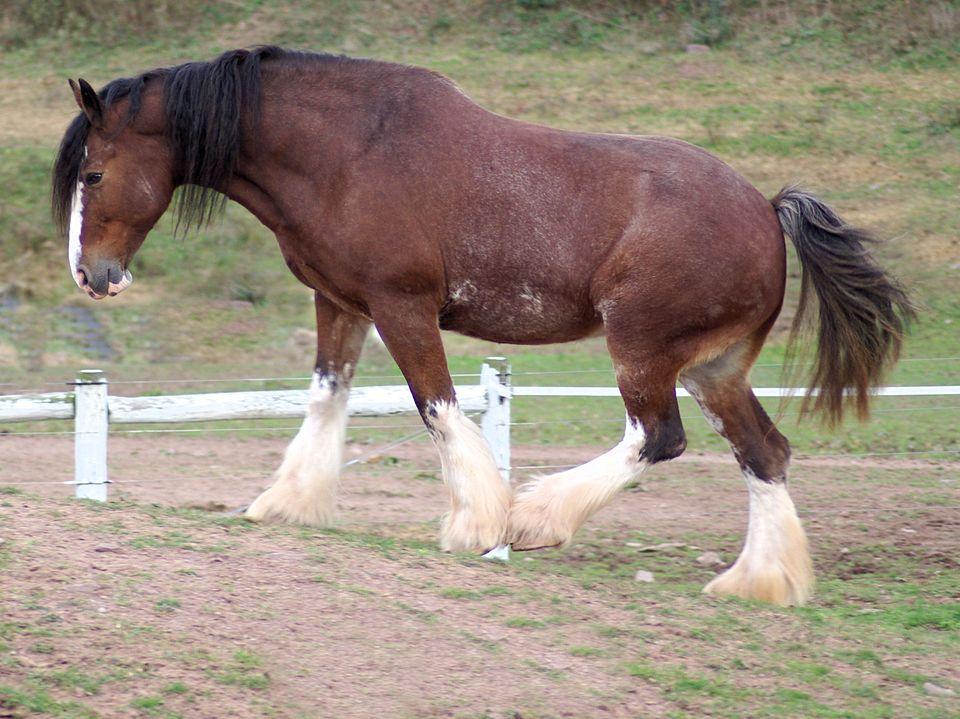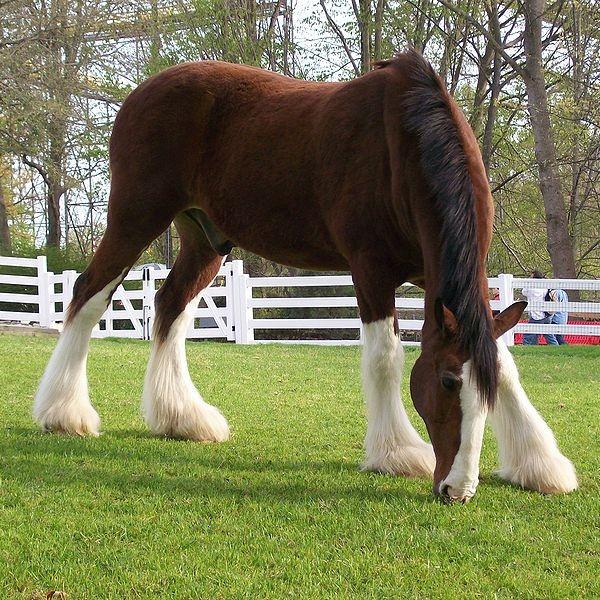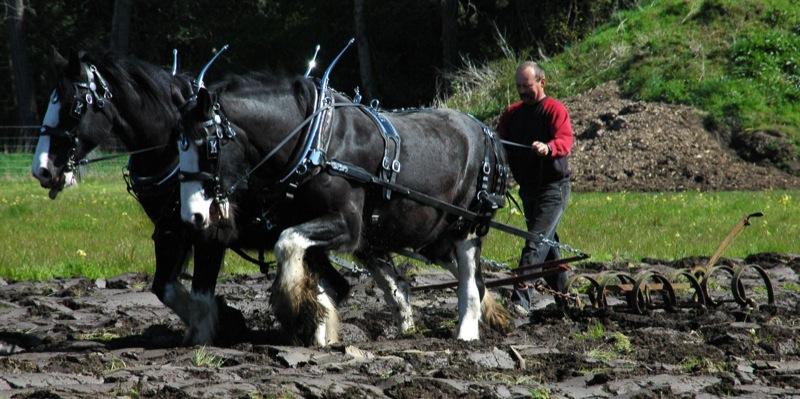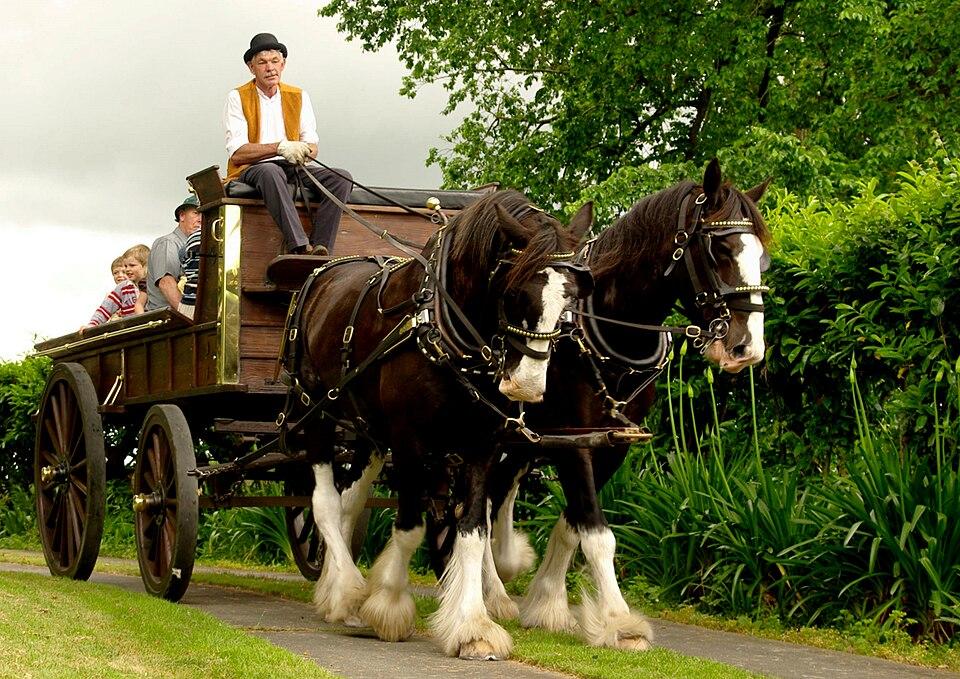
Continent: Europe
Country: Scotland
Weight: 800 – 1000 kg
Height: 173 – 183 cm




The Clydesdale horse originates from the Clyde Valley, in Lanarkshire, in the southwest of Scotland. Its development began in the early 18th century, when Scottish breeders crossed local mares with imported Flemish and Shire stallions.
From a cultural perspective, the Clydesdale embodies the image of the powerful Scottish farm horse, used for agricultural work in the fertile lands of the valley, but also for hauling carts in industrial cities such as Glasgow. It has become a symbol of Scottish rural pride, reflecting values of strength, hard work, and sobriety.
Today, the Clydesdale retains a special place in popular culture, notably through the iconic brewery teams (such as Budweiser) and heritage parades, preserving a strong link between the breed and the industrial and agricultural history of Scotland.
Historically bred in Lanarkshire, in the heart of the Clyde Valley in Scotland, the Clydesdale spread widely to other regions and countries thanks to its reputation as a powerful and elegant draft horse.
Today, the main breeding areas are:
United Kingdom:
– Scotland (particularly the southwest)
– Northern England
North America:
– Canada: provinces of Ontario, Alberta, and Saskatchewan
– United States: mainly in the Midwest and the plains (Missouri, Iowa, Ohio, etc.)
Australia and New Zealand:
The Clydesdale is the most widespread draft breed in Australia, originally used in agriculture and transport.
Continental Europe:
Modest presence in France, Germany, the Netherlands, and Scandinavia, generally in specialized breeding farms or for show purposes.
The Clydesdale holds a significant place in the history of equine genetics, particularly among heavy draft breeds. Its genetic importance is evident on several levels.
Improvement of draft breeds worldwide:
The Clydesdale was extensively exported during the 19th and 20th centuries, especially to North America, Australia, and New Zealand, where it contributed to the creation or strengthening of local heavy draft and driving breeds.
Transmission of specific morphological traits:
Its harmonious conformation, abundant feathering, power combined with a certain elegance, and docile temperament have influenced other bloodlines, particularly those intended for prestige driving.
Genetic diversity within British breeds:
The Clydesdale shares partial ancestry with the Shire, but has retained distinct characteristics (lighter, more active, more refined), helping to maintain genetic diversity within British draft horses.
However, despite this historical influence, the breed is now considered vulnerable (“at risk” status according to the Rare Breeds Survival Trust), underlining the importance of preserving its unique genetic heritage.
The Clydesdale horse traces its origins to the early 18th century in Lanarkshire, in the southwest of Scotland, within the Clyde Valley. At that time, local farmers sought to improve their farm horses for heavy work. They crossed robust Scottish mares with imported Flemish stallions (often of the Brabant or Shire type), bringing strength, stature, and endurance.
The name “Clydesdale” first appeared around 1826, referring to the draft horses bred in the Clyde region. Their popularity quickly grew thanks to their pulling power and docile nature, making them especially suited for agricultural work, hauling heavy loads (notably in cities such as Glasgow), and industrial transport.
The official stud-book was established in 1877 with the creation of the Clydesdale Horse Society, marking the recognition and standardization of the breed.
Global Expansion:
During the 19th and early 20th century, the Clydesdale was extensively exported:
– To North America, contributing to agricultural and industrial efforts.
– To Australia and New Zealand, where it became the main draft horse.
– To other regions of the world where mechanized farming had not yet taken hold.
Decline:
With the mechanization of agriculture after World War II, demand for draft horses collapsed. The number of Clydesdales fell dramatically, threatening the breed’s survival.
Revival:
Since the 1970s–1980s, renewed interest in heritage breeds and alternative uses (logging, recreational driving, shows) has allowed the breed to endure, though its global population remains limited. Today, it is protected and promoted by associations dedicated to agricultural heritage and draft horses.
Thus, the Clydesdale has transitioned from being a pillar of rural and urban labor to a cultural symbol and an emblem of Scottish tradition.
The Clydesdale is renowned for its gentle, calm, and cooperative temperament, making it a highly valued draft horse both for work and for leisure or ceremonial activities. Here are its main character traits:
- Docile and easy to handle – despite its large size, it is generally very respectful towards humans, making it accessible even to beginners (with proper supervision).
- Hardworking and enduring – historically accustomed to heavy loads and long days, it retains a strong work ethic and willingness.
- Intelligent and responsive – it quickly understands instructions and adapts well to different situations, especially in driving.
- Sociable – gets along well with both humans and other horses, without showing excessive dominance.
- Steady and composed – not easily startled, it is rarely prone to spooking or panic, making it particularly reliable in public events or noisy environments (parades, fairs).
In summary, the Clydesdale embodies the “gentle giant” of the equine world: impressive in stature, yet profoundly peaceful, patient, and loyal.
The Clydesdale’s prospects are both concerning and promising, depending on breeding, conservation, and cultural promotion dynamics.
Challenges:
– The breed is classified as “vulnerable” by the Rare Breeds Survival Trust (fewer than 900 breeding mares in the UK).
– The modernization of agriculture and mechanization have drastically reduced the need for heavy draft horses.
– Inbreeding and the reduction of the global population threaten genetic diversity.
Sustaining factors:
– The Clydesdale benefits from strong heritage and touristic appeal, particularly through parades, demonstration hitches (e.g., Budweiser in the United States), and traditional equestrian events.
– The breed is valued in leisure and prestige driving, as well as in ecological logging or sustainable farming projects.
– Genetic conservation programs are in place, notably in Scotland, Canada, and Australia.
– Its iconic image makes it an ambassador of draft breeds, used in communication, advertising, and shows.
The survival of the Clydesdale depends on its ability to adapt to new uses (leisure, tourism, ecological traction), to strengthen international cooperation between breeders, and to maintain active promotion to the public. If these efforts continue, the breed can hope not only to survive, but also to expand into rewarding niches.
The Clydesdale is generally a robust and hardy horse, but its large size and certain morphological traits require specific attention.
Strengths:
- Physical endurance – bred for heavy work, it has excellent stamina and a solid constitution.
- Longevity – with proper care, it can live 25 to 30 years, which is remarkable for a draft horse.
Specific vulnerabilities:
- Skin issues under the feathering – chronic dermatitis (such as mud fever) is common due to moisture retention in the abundant feathering. Regular, thorough maintenance is essential.
- White sabino gene syndrome – certain highly white-marked bloodlines may carry a genetic mutation linked to pigmentation or health anomalies.
- Joint problems – its considerable mass predisposes it to joint disorders (arthritis, tendonitis), especially if worked or ridden too young or on unsuitable ground.
- Atypical myopathy – like other draft horses, it may be more sensitive to certain toxins, particularly those from maple seeds.
Health recommendations:
- Regular veterinary check-ups, especially for legs and skin.
- Thorough feather care (brushing, drying, parasite control).
- Balanced diet – avoid excess weight.
- Moderate but regular exercise to maintain muscular and joint health.
In summary, the Clydesdale is a healthy horse provided it receives care adapted to its morphology, especially rigorous leg hygiene.